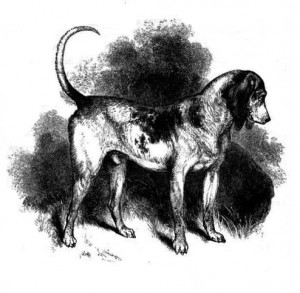By Lisa Smith, W&M Contributor
Snoopy, the world’s most famous beagle, epitomizes several of the breed’s traits: the dangly ears, the prominent snout, the fixation on food. But in the cartoon, he retreats regularly to an imaginary world of adventures to escape the monotony of a dog’s life. An eighteenth-century beagle’s life would, perhaps, have been of more interest to him—the confinement of kennel-life interspersed with the thrill of the hunt. Beagles became an established hunting breed in the fifteenth century and, by the early eighteenth century, there was much information on how to build the best beagle hunting pack.

An illustration of the Southern Hound. From J.H. Walsh, The dog, in health and disease, by Stonehenge (1859). Source: Wikimedia Commons.
The breed that we know and (in my case) love today was very different in early modern England. The term beagle was used until the eighteenth century to describe several sorts of hounds, including the harrier.[1] The smallest of the hounds, beagles were used primarily for chasing hares and were known for their “exquisite smell” and perseverance.[2] By the eighteenth century, there were three main types of beagle, outlined in 1788 by Cynegetica or essays on sporting consisting of observations on hare hunting &c. The wire-haired Northern Beagle was small (about 12 inches), fast, impetuous and cheerful, doing “his business as furiously as Jehu himself can wish him”. The smooth-haired Southern Beagle was larger, rangier, phlegmatic, slower and patient. A third type of beagle was a small lapdog, which—according to The Sportsman’s Dictionary (vol. 1, 1705)—makes a pretty diversion in hunting the coney”, but was otherwise not serviceable.
Building “a neat Pack [was] somewhat difficult”, advised James Lambert in 1710 (The Countryman’s Treasure). Lambert specified that the hounds should be well-matched with each other or “one will hinder another”. Cynegetica and other books recommended that the owner breed the Northern and Southern types together, with the goal of producing offspring that would keep the tenacious scent-tracking of the Southern with a little of the Northern’s speed. The Sportsman’s Dictionary suggested that, when crossed, they would make “great killers”. Lambert added to this that there should be two “Hunts on the Highway” to follow scent on hard ground and “two old staunch Hounds” to moderate the “over-swiftness of the younger and unexperienced”.
The owner should also take care to match the pack to his own temperament; the slowness of the Southern Beagle, say, might prove “trifling and tedious” to a man who preferred speed (Cynegetica). Particular care should also be taken in the musicality of the pack, for as Ralph Beilby described, beagle “tones are soft and musical, and add greatly to the pleasures of the chase”. Lambert gave thought as to how the pack owner might achieve “better Harmony”: “some whiners and Treble-cryers are necessary”. A well-balanced pack of twenty beagles would be most efficient and provide the most pleasure in the hunt.
There was also much advice on the care of the pack, from conception to diet. The hunting dogs were, perhaps, afforded better care than many people in early modern society. Nicholas Cox wrote that the female should be strong and well-proportioned, while the sire should be young. An old sire would result in “dull and heavy whelps”. A pregnant female should be allowed free range of the house and fed hot broth daily (The huntsman, 1780). Suitable hound names, as listed by Cox, included noble titles (Younker, Countess, Cesar, Duke), flowers (Lily, Tulip), mythological (Daphne, Hector, Dido, Juno), sounds (Music, Ranter, Thunder, Tatler) or personality (Fuddle, Wanton, Plunder, Merry-boy, Jolly-boy)…
Around the age of one, a dog could be introduced to the pack and would benefit, at first, from “the smack of the whip” (The gentleman farrier, 1732). Lambert outlined the pack’s daily care routine. Kennels should be dry, warm and vermin-free, with a supply of clear water and daily sun. The dogs should also have access to a “chimney-fire in cold damp weather” where they could cool down after a hunt. This would prevent diseases like mange, itch and fever, which were thought to be caused by sudden changes in bodily temperature. Their food was to be given throughout the day and included broth with crusts, table scraps and whey and milk with bran.
There was an art to beagling, which entailed close attention to hound care, breeding and pack harmony. The descriptions of an ideal pack reflected wider social ideals of obedience, stability, mastery and efficiency, as well as highlighted the quality of life gap between the poor in society and their squires’ dogs. By 1800, Sydenham Edwards claimed that it was rare to see a full pack of beagles any more. Instead, the beagles were kept primarily as finders to greyhounds in coursing. As huntsmen turned their attention from hares to foxes, beagling fell out of fashion and, over the nineteenth century, a more modern beagle was born. But one thing remains constant, as Snoopy’s pursuit of the Red Baron shows: dogged perseverance.
[1] Sydenham Edwards, Cynographia Britannica (London, 1800).
[2] Ralph Beilby, A general history of quadrupeds (Newcastle-upon-Tyne, 1790).
Lisa Smith is an Associate Professor of History at the University of Saskatchewan. She writes on gender, family, and health care in England and France (ca. 1600-1800), as well as teaches a course on “Defining Boundaries: Natural and Supernatural Worlds in Early Modern Europe”. She also blogs weekly on history of medicine and science at her Sloane Letters Blog and edits The Recipes Project. Follow her on Twitter, where she tweets as @historybeagle.
This post was first released at Wonders & Marvels on 30 May 2013.
